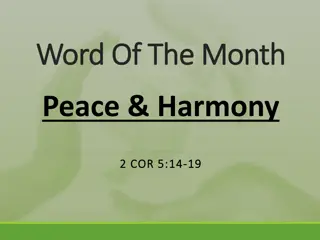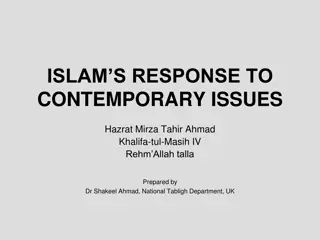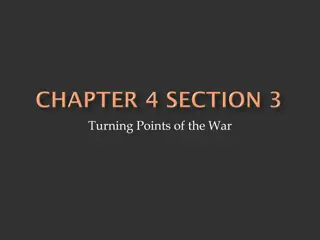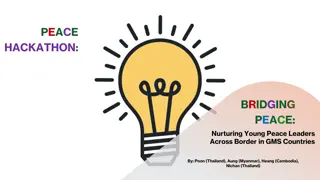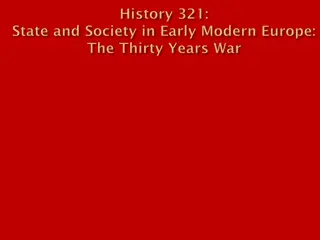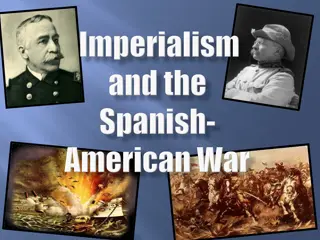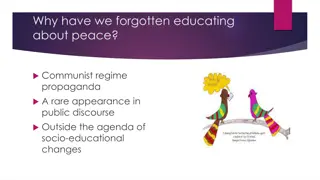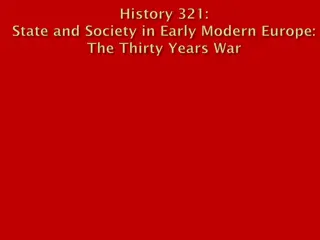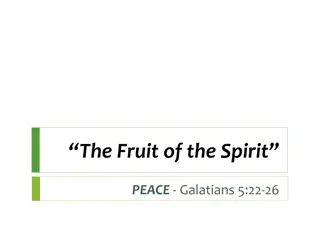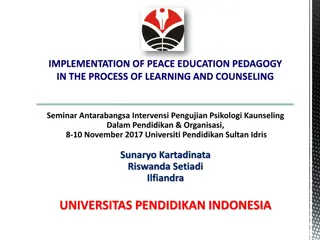Thirty Years War and the Peace of Westphalia: A Turning Point in European History
The Thirty Years War, often regarded as a meaningless conflict in European history, led to the Peace of Westphalia, which marked the birth of the modern international order based on sovereign states. While the Peace of Westphalia did not resolve all conflicts, it introduced the concept of indivisible sovereignty and set the stage for a more secular order with equal, sovereign states. This period also saw the decline of the Empire and the emergence of new powers like France and Sweden as guarantors of the Westphalian Treaties.
Download Presentation

Please find below an Image/Link to download the presentation.
The content on the website is provided AS IS for your information and personal use only. It may not be sold, licensed, or shared on other websites without obtaining consent from the author.If you encounter any issues during the download, it is possible that the publisher has removed the file from their server.
You are allowed to download the files provided on this website for personal or commercial use, subject to the condition that they are used lawfully. All files are the property of their respective owners.
The content on the website is provided AS IS for your information and personal use only. It may not be sold, licensed, or shared on other websites without obtaining consent from the author.
E N D
Presentation Transcript
The test will take place in class on Tuesday, 7 April. It will have the same format as the previous two tests but will be slightly longer. You will have 45 minutes to complete it. The test will begin at 11:30 and end at 12:15. After the test, you will complete the course evaluation forms. Bring a pencil to complete the forms. Someone will need to volunteer to collect the forms and return them to the Department of History. I shall try to have the tests marked by Wednesday, 8 April. You can pick them up from my office between 9:30 and 10:00.
Submit your final paper by email to pabel@sfu.ca by 9:30 am on Thursday, 9 April. I shall return your papers by email. If you have questions about my comments or grade, you must see me in person. I shall be available to discuss papers on Thursday, 16 April from 13:30 to 15:00. Please let me know in advance if you wish to meet with me.
How did peace come to the Empire after the Thirty Years War?
the birth of the modern international order based on sovereign states (751) the Thirty Years War solved no problem. it is the outstanding example in European history of meaningless conflict (C. V. Wedgwood) the end of Germany
The Thirty Years War was not a general European or a global conflict. The Peace of Westphalia did not settle all European conflicts or colonial conflicts. war between France and Spain: Peace of the Pyrenees (1659) renewed Baltic wars (1655): Sweden, Poland, Russia: Treaty of Oliva (1660)
Westphalias significance lies not in the number of conflicts it tried to resolve, but in the methods and ideals it applied (753). The classic Westphalian state rests on indivisible sovereignty. it possesses well- demarcated, non-porous borders, and a common identity and culture among its inhabitants (754) an ideal not immediately evident immediately after 1648 development: Europe remained a hierarchical, fragmented international system after 1648, but was clearly moving towards as secular order based on more equal, sovereign states (754).
decline of the Empire? Dutch neutrality and Swiss independence? the lingering sense of the Empire as embodying the ideal of a single European political community (755) France and Sweden as guarantors of the Westphalian Treaties: limits and limitations Sweden and France as supporters of the Imperial constitution in the eighteenth century.
religious dimensions solution to religious problems with an amicable composition (758) itio in partes 1 January 1624: new normative date acceptance of Calvinism besides Lutheranism, Catholicism limited right of Reformation exception for the Habsburgs
religious dimensions disparity of rights for religious majorities and minorities Toleration was thus not based on individual equal rights but on membership of a community with corporate rights (760). genuine compromise among three confessions (760). three privileged churches with equal status (761)
religious dimensions Rather than secularizing politics, the Thirty Years War discredited the use of force to obtain confessional or political objectives within the Empire (760) limited confessional conflict Centralized states imposed official uniformity through an established church and then widened opportunities for others through limited toleration (761)
Nrnberg Execution Congress (1649) troop withdrawal disputes over normative year Reichshofrat (imperial supreme court) bi-confessional deputation of imperial estates (1649-1651) deputation of 1655 Reichshofrat, Reichskammergericht exceptions: Swedish land distribution, ignoring minority rights some confessional tensions, pragmatism too (vs. toleration, secularization)
Discrediting violence as a tool of oppression (766) D sseldorf Cow War Brandenburg vs. Pfalz-Neuburg in inheritance dispute: invasion, counter-invasion pressure from Dutch Republic, Sweden, Emperor amicable agreements in 1666 and 1672 (767)
Discrediting violence as a tool of oppression (766) Palatine controversy, 1685-1705 Catholic elector challenged normative year 31 princely conversions to Catholicism: 1648-1769 solution: equal rights for all Christian churches in Palatinate The controversy underscores how the Thirty Years War changed imperial political culture. The disputes after 1648 no longer concerned fundamental truth, but the relative weight of Protestant and Catholic territories in imperial institutions (769).
Discrediting violence as a tool of oppression (766) 1/3 of 750 official complaints about infringement of religious rights (768): 1648- 1803 political struggles between Brandenburg and Saxony
Demobilization 160,000 soldiers scattered across the Empire (769) to be supported financially by areas in which they were stationed until withdrawal
Demobilization Sweden exaggerated actual number of troops: 125,000 withdrew troops from southern to northern Germany received additional 200,000 taler to accelerate withdrawal received 90% of 5.2 M taler by June 1650 deadline; 97% when troops withdrew from Vechta (occupied since 1647) in 1654
Demobilization Bavaria all soldiers discharged except for Elector s bodyguard Imperial army reduced from 42,300 to 26,230 standing army social integration of soldiers marauders watchmen eventual success
Regensburg Reichstag, 1653-1654 Article 6 of Recess IPO and IPM and N rnberg Recess, 1650: permanent fundamental laws of the Empire Empire was a mixed monarchy where power was exercised in unequal shares by the emperor and imperial Estates (774)
Restoration of Habsburg influence in Empire retention of imperial prerogatives acceptance of limitations to imperial authority: elevations to princely status cultivation of good relations with leading Estates retention of imperial title for Habsburgs: election of Ferdinand IV (d. July 1654) death of Ferdinand III (2 April 1657) Leopold I (1658-1705) assistance to Spanish Habsburgs
Strengthening of territorial rulers (imperial Estates) i.e. electors, princes, free imperial cities territorial Estates (representative bodies) weakened prohibited from raising militias or making agreements with foreign powers imperial Estates: equal participants with Emperor in governing the Empire
Strengthening of territorial rulers (imperial Estates) territorial rulers may make alliances with foreign powers but not for confessional reasons or for German liberties Alliances should be oriented at sustaining the constitution of the Empire (777). Alliances could not be directed against the Emperor or Empire.
Far from leaving the Empire an empty shell, the Westphalian settlement thus injected new life into its constitution and strengthened its political culture. Stabilization of the Empire contributed to European peace by removing a source of tension from the heart of the continent. The spectre of Catholic Habsburg hegemony had been banished, not least because Spain had been bled dry by its own prolonged conflicts (778).





